2016 Hyundai Santa Fe Front passenger seat
[x] Cancel search: Front passenger seatPage 21 of 699
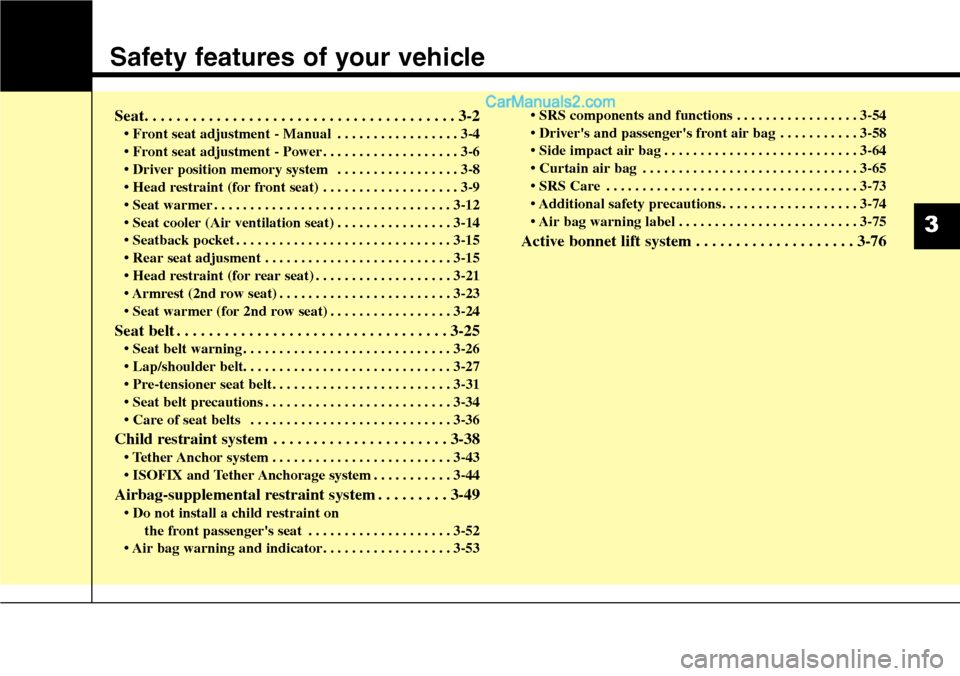
Safety features of your vehicle
Seat. . . . . . . . . . . . . . . . . . . . . . . . . . . . . . . . . . . . . . . 3-2
• Front seat adjustment - Manual . . . . . . . . . . . . . . . . . 3-4
• Front seat adjustment - Power . . . . . . . . . . . . . . . . . . . 3-6
• Driver position memory system . . . . . . . . . . . . . . . . . 3-8
• Head restraint (for front seat) . . . . . . . . . . . . . . . . . . . 3-9
• Seat warmer . . . . . . . . . . . . . . . . . . . . . . . . . . . . . . . . . 3-12
• Seat cooler (Air ventilation seat) . . . . . . . . . . . . . . . . 3-14
• Seatback pocket . . . . . . . . . . . . . . . . . . . . . . . . . . . . . . 3-15
• Rear seat adjusment . . . . . . . . . . . . . . . . . . . . . . . . . . 3-15
• Head restraint (for rear seat) . . . . . . . . . . . . . . . . . . . 3-21
• Armrest (2nd row seat) . . . . . . . . . . . . . . . . . . . . . . . . 3-23
• Seat warmer (for 2nd row seat) . . . . . . . . . . . . . . . . . 3-24
Seat belt . . . . . . . . . . . . . . . . . . . . . . . . . . . . . . . . . . 3-25
• Seat belt warning . . . . . . . . . . . . . . . . . . . . . . . . . . . . . 3-26
• Lap/shoulder belt. . . . . . . . . . . . . . . . . . . . . . . . . . . . . 3-27
• Pre-tensioner seat belt. . . . . . . . . . . . . . . . . . . . . . . . . 3-31
• Seat belt precautions . . . . . . . . . . . . . . . . . . . . . . . . . . 3-34
• Care of seat belts . . . . . . . . . . . . . . . . . . . . . . . . . . . . 3-36
Child restraint system . . . . . . . . . . . . . . . . . . . . . . 3-38
• Tether Anchor system . . . . . . . . . . . . . . . . . . . . . . . . . 3-43
• ISOFIX and Tether Anchorage system . . . . . . . . . . . 3-44
Airbag-supplemental restraint system . . . . . . . . . 3-49
• Do not install a child restraint on
the front passenger's seat . . . . . . . . . . . . . . . . . . . . 3-52
• Air bag warning and indicator. . . . . . . . . . . . . . . . . . 3-53• SRS components and functions . . . . . . . . . . . . . . . . . 3-54
• Driver's and passenger's front air bag . . . . . . . . . . . 3-58
• Side impact air bag . . . . . . . . . . . . . . . . . . . . . . . . . . . 3-64
• Curtain air bag . . . . . . . . . . . . . . . . . . . . . . . . . . . . . . 3-65
• SRS Care . . . . . . . . . . . . . . . . . . . . . . . . . . . . . . . . . . . 3-73
• Additional safety precautions . . . . . . . . . . . . . . . . . . . 3-74
• Air bag warning label . . . . . . . . . . . . . . . . . . . . . . . . . 3-75
Active bonnet lift system . . . . . . . . . . . . . . . . . . . . 3-763
Page 23 of 699
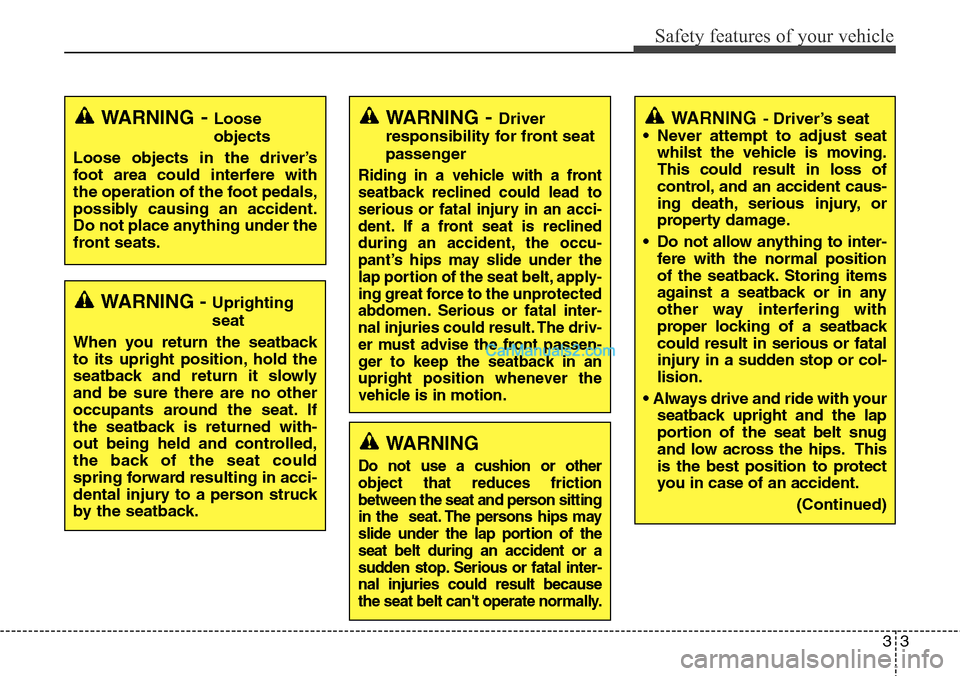
33
Safety features of your vehicle
WARNING - Uprighting
seat
When you return the seatback
to its upright position, hold the
seatback and return it slowly
and be sure there are no other
occupants around the seat. If
the seatback is returned with-
out being held and controlled,
the back of the seat could
spring forward resulting in acci-
dental injury to a person struck
by the seatback.
WARNING- Loose
objects
Loose objects in the driver’s
foot area could interfere with
the operation of the foot pedals,
possibly causing an accident.
Do not place anything under the
front seats.WARNING- Driver
responsibility for front seat
passenger
Riding in a vehicle with a front
seatback reclined could lead to
serious or fatal injury in an acci-
dent. If a front seat is reclined
during an accident, the occu-
pant’s hips may slide under the
lap portion of the seat belt, apply-
ing great force to the unprotected
abdomen. Serious or fatal inter-
nal injuries could result. The driv-
er must advise the front passen-
ger to keep the seatback in an
upright position whenever the
vehicle is in motion.
WARNING
Do not use a cushion or other
object that reduces friction
between the seat and person sitting
in the seat. The persons hips may
slide under the lap portion of the
seat belt during an accident or a
sudden stop. Serious or fatal inter-
nal injuries could result because
the seat belt can't operate normally.
WARNING- Driver’s seat
• Never attempt to adjust seat
whilst the vehicle is moving.
This could result in loss of
control, and an accident caus-
ing death, serious injury, or
property damage.
• Do not allow anything to inter-
fere with the normal position
of the seatback. Storing items
against a seatback or in any
other way interfering with
proper locking of a seatback
could result in serious or fatal
injury in a sudden stop or col-
lision.
• Always drive and ride with your
seatback upright and the lap
portion of the seat belt snug
and low across the hips. This
is the best position to protect
you in case of an accident.
(Continued)
Page 29 of 699
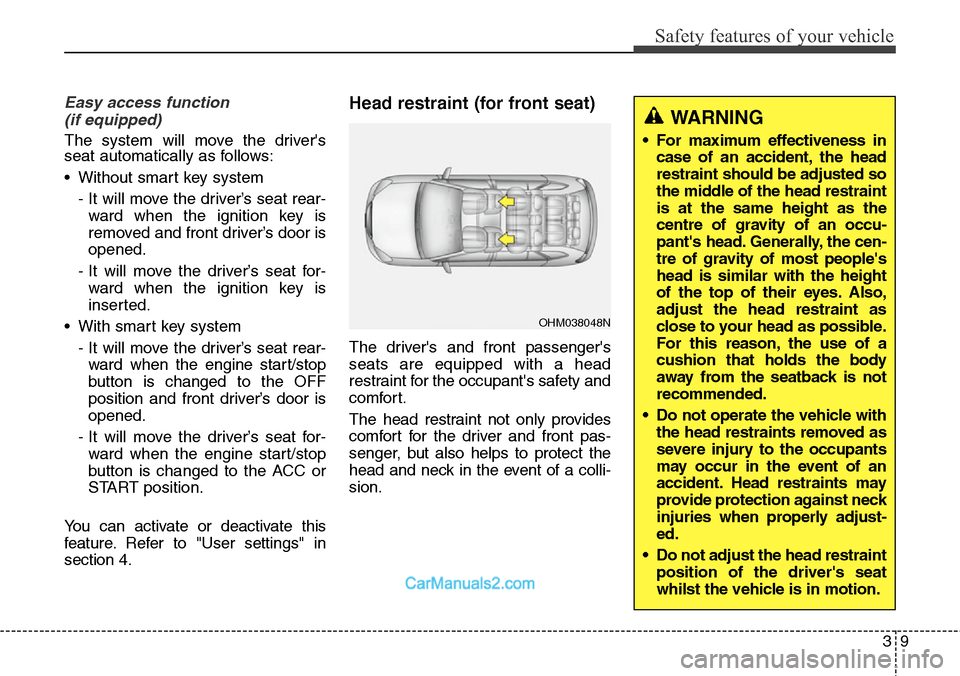
39
Safety features of your vehicle
Easy access function
(if equipped)
The system will move the driver's
seat automatically as follows:
• Without smart key system
- It will move the driver’s seat rear-
ward when the ignition key is
removed and front driver’s door is
opened.
- It will move the driver’s seat for-
ward when the ignition key is
inserted.
• With smart key system
- It will move the driver’s seat rear-
ward when the engine start/stop
button is changed to the OFF
position and front driver’s door is
opened.
- It will move the driver’s seat for-
ward when the engine start/stop
button is changed to the ACC or
START position.
You can activate or deactivate this
feature. Refer to "User settings" in
section 4.
Head restraint (for front seat)
The driver's and front passenger's
seats are equipped with a head
restraint for the occupant's safety and
comfort.
The head restraint not only provides
comfort for the driver and front pas-
senger, but also helps to protect the
head and neck in the event of a colli-
sion.
OHM038048N
WARNING
• For maximum effectiveness in
case of an accident, the head
restraint should be adjusted so
the middle of the head restraint
is at the same height as the
centre of gravity of an occu-
pant's head. Generally, the cen-
tre of gravity of most people's
head is similar with the height
of the top of their eyes. Also,
adjust the head restraint as
close to your head as possible.
For this reason, the use of a
cushion that holds the body
away from the seatback is not
recommended.
• Do not operate the vehicle with
the head restraints removed as
severe injury to the occupants
may occur in the event of an
accident. Head restraints may
provide protection against neck
injuries when properly adjust-
ed.
• Do not adjust the head restraint
position of the driver's seat
whilst the vehicle is in motion.
Page 32 of 699

Safety features of your vehicle
12 3
3. Adjust the head restraint to the
appropriate height.Seat warmer (if equipped)
ODMESA2010R
ODMESA2012R
■Type A
■Type BODMESA2011R
ODMESA2013R
■Type C
■Type D
The seat warmer is provided to warm the front seats during cold weather.
With the ignition switch in the ON position, push either of the switches to
warm the driver's seat or the front passenger's seat.
During mild weather or under conditions where the operation of the seat
warmer is not needed, keep the switches in the "OFF" position.
WARNING
Always make sure the head
restraint locks into position
after reinstalling and adjusting
it properly.
Page 35 of 699

315
Safety system of your vehicle
Seatback pocket
The seatback pocket is provided on
the back of the front passenger’s and
driver’s seatbacks.
Rear seat adjustment
Forward and backward
(2nd row seat)
To move the seat forward or back-
ward:
1. Pull the seat slide adjustment
lever up and hold it.
2. Slide the seat to the position you
desire.
3. Release the lever and make sure
the seat is locked in place.
Adjust the seat before driving, and
make sure the seat is locked secure-
ly by trying to move forward and
backward without using the lever. If
the seat moves, it is not locked prop-
erly.
Seatback angle (2nd row seat)
To recline the seatback:
1. Pull up the seatback recline lever.
2. Hold the lever and adjust the seat-
back of the seat to the position you
desire.
3. Release the lever and make sure
the seatback is locked in place.
(The lever MUST return to its orig-
inal position for the seatback to
lock.)
ODM032019
ODM032020OCM030052
WARNING- Seatback
pockets
Do not put heavy or sharp
objects in the seatback pockets.
In an accident they could come
loose from the pocket and
injure vehicle occupants.
Page 36 of 699

Safety features of your vehicle
16 3
Walk-in seat
(2nd row seat, if equipped)
To get in or out of the 3rd row seat,
1. Routing the seat belt webbing
through the rear seat belt guide clip.
After inserting the seat belt, tighten
the belt webbing by pulling it up.
2. Pull up the walk-in lever (1) on the
2nd row seatback.3.The 2nd row seatback will be fold-
ed and push the seat to the far-
thest forward position.
After getting in or out, slide the 2nd
row seat to the farthest rearward
position and pull the seatback firm-
ly backward until it clicks into
place. Make sure that the seat is
locked in place.
Folding the rear seat
The rear seatbacks can be folded to
facilitate carrying long items or to
increase the luggage capacity of the
vehicle.
ODM032055
WARNING
The purpose of the fold-down
rear seatbacks is to allow you to
carry longer objects that could
not be accommodated in the
cargo area.
Never allow passengers to sit
on top of the folded down seat-
back whilst the vehicle is mov-
ing. This is not a proper seating
position and no seat belts are
available for use. This could
result in serious injury or death
in case of an accident or sud-
den stop. Objects carried on the
folded down seatback should
not extend higher than the top
of the front seatbacks. This
could allow cargo to slide for-
ward and cause injury or dam-
age during sudden stops.
WARNING
Never attempt to adjust whilst
the vehicle is moving or the 2nd
row seat is occupied as the seat
may suddenly move and cause
the passenger on the seat to be
injured.
ODM032027
ODM032021
Page 39 of 699
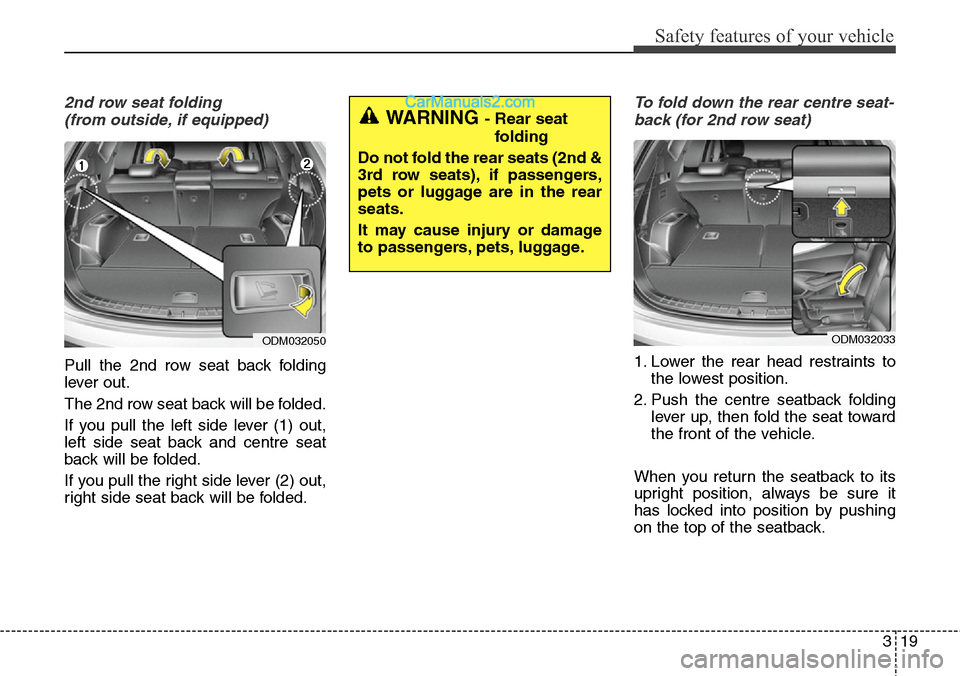
319
Safety features of your vehicle
2nd row seat folding
(from outside, if equipped)
Pull the 2nd row seat back folding
lever out.
The 2nd row seat back will be folded.
If you pull the left side lever (1) out,
left side seat back and centre seat
back will be folded.
If you pull the right side lever (2) out,
right side seat back will be folded.
To fold down the rear centre seat-
back (for 2nd row seat)
1. Lower the rear head restraints to
the lowest position.
2. Push the centre seatback folding
lever up, then fold the seat toward
the front of the vehicle.
When you return the seatback to its
upright position, always be sure it
has locked into position by pushing
on the top of the seatback.
ODM032033ODM032050
WARNING - Rear seat
folding
Do not fold the rear seats (2nd &
3rd row seats), if passengers,
pets or luggage are in the rear
seats.
It may cause injury or damage
to passengers, pets, luggage.
Page 41 of 699
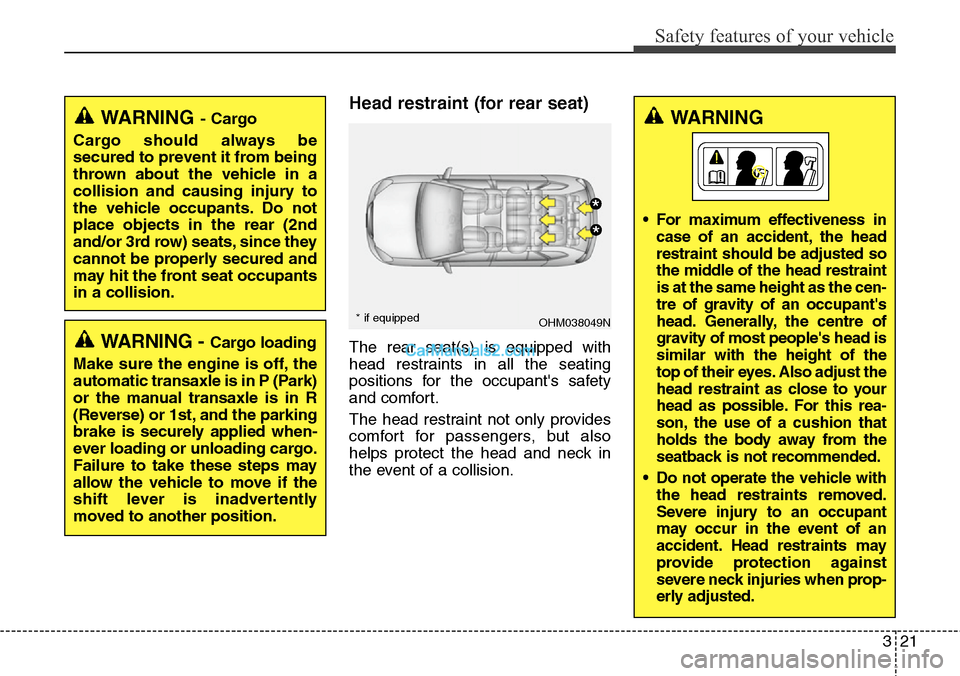
321
Safety features of your vehicle
Head restraint (for rear seat)
The rear seat(s) is equipped with
head restraints in all the seating
positions for the occupant's safety
and comfort.
The head restraint not only provides
comfort for passengers, but also
helps protect the head and neck in
the event of a collision.
WARNING- Cargo
Cargo should always be
secured to prevent it from being
thrown about the vehicle in a
collision and causing injury to
the vehicle occupants. Do not
place objects in the rear (2nd
and/or 3rd row) seats, since they
cannot be properly secured and
may hit the front seat occupants
in a collision.
WARNING - Cargo loading
Make sure the engine is off, the
automatic transaxle is in P (Park)
or the manual transaxle is in R
(Reverse) or 1st, and the parking
brake is securely applied when-
ever loading or unloading cargo.
Failure to take these steps may
allow the vehicle to move if the
shift lever is inadvertently
moved to another position.
OHM038049N
*
*
* if equipped
WARNING
• For maximum effectiveness in
case of an accident, the head
restraint should be adjusted so
the middle of the head restraint
is at the same height as the cen-
tre of gravity of an occupant's
head. Generally, the centre of
gravity of most people's head is
similar with the height of the
top of their eyes. Also adjust the
head restraint as close to your
head as possible. For this rea-
son, the use of a cushion that
holds the body away from the
seatback is not recommended.
• Do not operate the vehicle with
the head restraints removed.
Severe injury to an occupant
may occur in the event of an
accident. Head restraints may
provide protection against
severe neck injuries when prop-
erly adjusted.